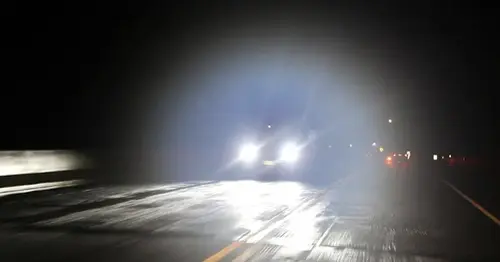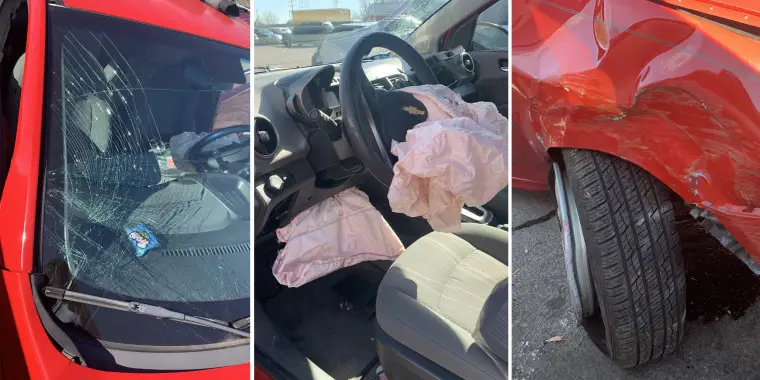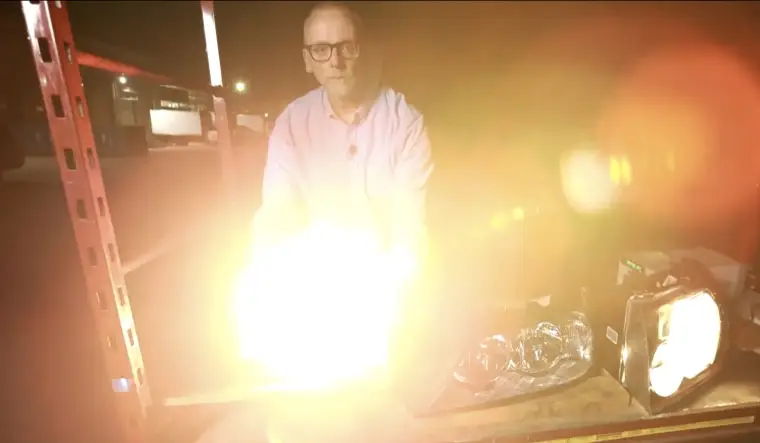
Blinded by the light: U.S. cars still lack glare-reducing headlights
One night in early November, Aaron Madrid was driving home from his job at a haunted house outside Chicago when he faced an unexpected horror. The lights from an oncoming pickup truck hit him dead in the eyes, blinding him.
“I was completely disoriented and couldn’t see for five to 10 seconds,” the 22-year-old said. “I didn’t realize I had swerved into the oncoming traffic lane. By the time I regained my eyesight, I had already hit the curb and then I hit a tree.”
Madrid’s Chevy Sonic was totaled, but he was lucky, stumbling out of the vehicle without major injury, just some bruising where the airbags had hit his thighs. “It was traumatic. I didn’t know what happened to me till my car had stopped.”
It’s nearly impossible to know how often headlight glare causes crashes like Madrid’s, according to automotive safety experts. But improving lighting to help prevent nighttime crashes — which have a fatality rate three times higher than daytime collisions — has been a priority for U.S. automakers, safety advocates and regulators for more than a decade. Yet Americans today may face more headlight glare and less effective headlights than drivers in other countries.
“The United States is decades behind the rest of the developed world with respect to updating standards to keep up with technologies, particularly in the headlight area,” said Greg Brannon, AAA’s director of automotive engineering and industry relations. “The standards have not been substantively updated since the ‘70s. Meanwhile, technology has marched on.”
Better road illumination and less glare from oncoming traffic are both key for safer night driving, automotive safety experts say. Technology that can do both at once — known as adaptive driving beams — has been used in Europe since 2012, according to automakers, and today it is available in cars sold in every major automotive market worldwide, except the U.S.

A 2022 regulation allowed the technology in the U.S. for the first time, but more than a year later, no vehicles with it are available for sale.
At the same time, Americans may be experiencing more glare. In the past two decades, vehicle headlights have shifted from primarily warm-yellowish halogen to cool-bluish LED, which human eyes are more sensitive to. New vehicles are increasingly taller, making oncoming headlights more likely to be eye-level for drivers in small cars. And few states annually check for headlight misalignment, which can lift light into an oncoming driver’s eyes.
That combination of risk factors makes it all the more important to get adaptive driving beams on U.S. roads, automotive safety researchers said. But the new rule’s testing requirements are so detailed and cumbersome that automakers say they would have to redesign the systems, potentially delaying implementation by years, despite the already available European technology. Safety researchers cautioned regulators against creating that kind of red tape years ago.
The National Highway Traffic Safety Administration said in a statement that its lighting standard “has long balanced the seeing needs of drivers while limiting glare to others.”
But the agency could not just adopt the European rule because the U.S. and Europe approve vehicle technology in different ways — automakers test their own vehicles to meet U.S. safety standards, while vehicles in Europe are tested by regulators. The U.S. and Europe also have different legal processes for approving new technology.
“NHTSA carefully considered the existing [European] regulation during the rule-making process,” the agency said. “In areas where that regulation lacked objective and measurable performance criteria required for the self-certification system in the United States, the agency adopted performance requirements to ensure safety for all road users.”
‘The capability is already there’
Many newer U.S. headlights automatically switch between high and low beams, which improves nighttime visibility. But adaptive driving beams can take those improvements much further, using constantly adjusting projected light to reduce glare by shining less light on occupied areas of the road and more on unoccupied ones. Research shows they make it much easier for drivers to spot pedestrians.
Getting this technology approved in the U.S. took nearly a decade. Toyota first petitioned the agency to allow adaptive driving beams in 2013, a year after they were introduced in Europe. Many NHTSA safety standards can take as long, but the agency had been researching glare since at least 2005 and began receiving consumer complaints about it as far back as 2001.
As the U.S. adaptive driving beam rule inched through the regulatory process, automakers were eager to offer the feature to American drivers. Audi, the first automaker to use the technology in 2012, began including in 2014 adaptive driving beam systems on some of its models sold in the U.S., in anticipation of regulation changing, but leaving them deactivated.
Adding the systems wasn’t difficult, as almost every Audi model has them as an optional feature and, in Europe, roughly half of Audi vehicles are sold with the technology, said Filip Brabec, the company’s senior vice president of product management. “For the U.S. specifically, we have well over 150,000 cars on the road today that could have it if we just turn it on. … The capability is already there.”
“It’s very frustrating,” he said. “We have technology that has been proven in many countries around the world, and we would just really like to bring it to the U.S.”
NBC News contacted five other major automakers to ask whether they sell U.S. vehicles with inactive ADB capabilities. Volkswagen Group, Audi's parent company, said it has 14,000 Volkswagen-brand vehicles in the U.S. market with it. Ford and Honda said they do not have any in the country and two others declined to comment or did not respond.

Industry experts, like the SAE (formerly called the Society of Automotive Engineers), which regulators consulted when writing the new rule, recommended the U.S. try to match the standard already in use as closely as possible.
The final rule explained the volume of tests as necessary to “meet the need for safety,” and said it had deviated from the SAE recommendation because it “does not adequately address the safety needs of visibility and glare prevention.”
A number of industry groups and companies, including Ford, Honda and Volkswagen, asked the NHTSA to reconsider its requirements, and the Alliance for Automotive Innovation, a trade group representing automakers, petitioned the agency to do so.
“The final rule contains several requirements that are either not practicable or not reasonable,” the group wrote in its petition. “If not adjusted, parts of this rule stand as an obstacle to the deployment of this important safety technology in the US market.”
NHTSA is still evaluating the petitions for reconsideration. For now, automakers say they have no clear timeline of when they will be able to introduce the technology in the U.S. When they do, it is likely to cost far more than current systems.
‘A lot of glare’
Adaptive driving beams can go a long way to make nighttime driving safer, but there are some things they can’t fix, safety researchers said.
Brannon, of AAA, said the new rule is “a step in the right direction,” but does not match European standards in part because the U.S. has a much lower maximum light output for high beams — a level set decades ago. “This technology could allow a greater light output because it’s shielding the things that shouldn’t be seeing the light at all. So it would have been a great time to up the light output standards.”
NHTSA is “not aware of any studies or data that demonstrate that increasing upper beam intensities would improve safety and doing so would likely increase glare levels on roadways in the United States,” an agency spokesperson said.
Despite that lack of change, longtime drivers likely feel that headlights have gotten brighter in the last few decades, as halogen headlights were replaced by more efficient LED lights.
“The light does look much brighter,” said John Bullough, program director at Mount Sinai’s Light and Health Research Center. “Our eyes are actually more sensitive to the bluer light that these lights can produce, compared to the yellow or light of the halogen lights.”
But glare is more a function of where headlights are aimed, rather than how bright they feel. And as taller vehicles like pickup trucks and large SUVs gain popularity, those headlights are more likely to shine into the eyes of drivers in lower mounted vehicles.
For Bullough, misalignment is the biggest issue. His research has found the majority of vehicles on the road have at least one mis-aimed headlight.
“Headlights aren’t like a flashlight, where they just throw out a beam of light, there’s a very sharp horizontal cutoff. So there’s a line below which headlights are very bright,” he explained. “When you’re 100 feet away, a little change in how that headlight is aimed can make a big difference in putting your eyes in that bright part of the headlight beam.”

Only 15 states require annual or biennial passenger vehicle inspections, and NBC News found that of those, 10 check headlight alignment. The five states that do not check alignment instead check other headlight functions, according to the inspection agencies. One of those, Hawaii, just passed a bill that would add headlight alignment to its inspection requirements; the measure now awaits the governor’s signature.
Two other states, New Jersey and Mississippi, stopped requiring mechanical safety inspections of passenger vehicles altogether in the last 13 years. New Jersey’s old inspections included headlight alignment.
Headlight alignment is easy enough to check and fix, Bullough said, and any mechanic should be able to do it. But if a driver is not in a state that requires that check, they have to know to ask for it.
Misalignment can happen with normal wear and tear, but even brand new vehicles may have misaligned headlights, because federal law does not require manufacturers to check alignment once headlights are mounted on vehicles. The Insurance Institute for Highway Safety, which tests headlight aim annually, has repeatedly asked federal regulators to add the testing to its requirements.
“If there’s a single issue with the regulation that we discovered [by testing] that needs to be fixed, it’s this issue of aim,” said Matthew Brumbelow, a senior research engineer at the Insurance Institute for Highway Safety. He has seen improvements in headlight aim in the years since they began evaluating it, but he said a federal requirement would be far better.
An NHTSA spokesperson said the agency has begun research into a federal requirement, after the 2021 Bipartisan Infrastructure Law directed it to develop a standard to “ensure that headlights are correctly aimed on the road.”
For now, said Bullough, the light researcher, the best advice for drivers is to get their vehicles’ headlight alignment checked, and if they are facing glare from oncoming headlights, to slow down, and try to look at the outside right edge of the road until it reduces.






